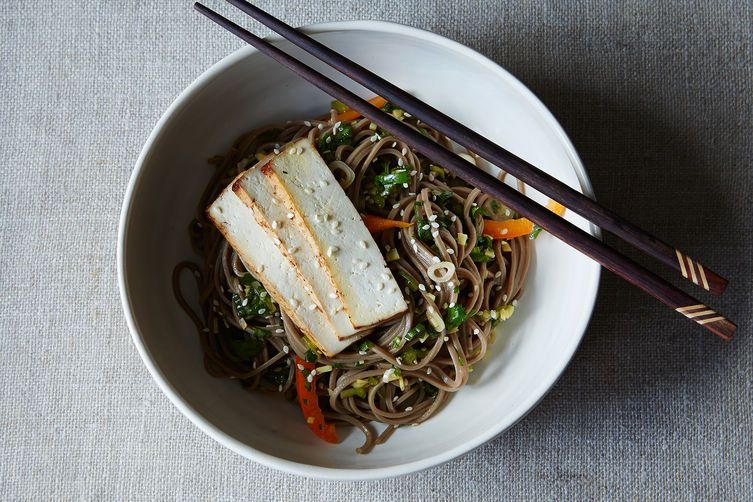The five underrated health food ingredients you should be buying (even if you don't wear Teva's).


Packed with shelves of kombucha, green juice bars, and wheatgrass, you could very easily breeze past natural food shops in favor of a grocery store that sells ice cream made from actual dairy and Cheez-its for a late-night snack emergency.
But wait! Take a step back. Hidden amongst the carob bars and the cheese-free cheese are a few oft-overlooked ingredients that can make our cooking (and snacking) a little better. Consider this: Natural food shops cater to the vegan, vegetarian, insert-diet-here crowd. Their customers need to find clever ways to recreate favorite tastes and to amp up the flavor when salt or dairy or meat is missing. So think of these ingredients as the culinary pinch hitters of your kitchen, ready to do the work.
Here are five you should try:
1. Apple Cider Vinegar

Acid is a brilliant way to instantly brighten up a dish. Like a pinch of salt, adding acid quickly takes flavors from flat to fascinating. You've probably got a few vinegars in your pantry: maybe white wine, red wine, and balsamic. Next time you shop, get apple cider vinegar, too. It's touted for everything from lowering blood sugar to helping with heart health. You can use it as an all-purpose cleaner, to soothe sunburn, to make your hair shiny, or as a room freshener. But most importantly, it tastes really good.
With a fruity, slightly sweet flavor, apple cider vinegar is ideal for salad dressings and pickling vegetables, like in this Caramelized Pork Bánh Mì sandwich. You can add it to a smoothie to offset the sweetness, or make a killer Alabama white barbecue sauce with it. It's Yossy Arefi's secret weapon for making perfect pie crust and it helps in baking a rich vegan chocolate cake.
2. Coconut Milk

Everyone's eating coconut these days: coconut water, coconut milk yogurt, giant juices out of whole coconuts on the street. This is a trend I support and you should hop on board, whether you eat dairy or not. Coconut milk—the liquid that comes from the grated meat of a brown coconut—is intensely rich and creamy, with a subtle sweetness. It tastes faintly tropical but is mild enough to pair with everything from fish to cake.
I recommend eating coconut milk morning, noon, and night. Start with breakfast: Toasted Almond Coconut Quinoa Porridge. For lunch, make Cheap Creamy Chicken Curry (coconut milk makes for an excellent curry). Choose from Crispy Coconut Kale with Roasted Salmon or Coconut-Lime Pork Tacos for dinner. Save room for dessert: Perfect Coconut Cream Pie, Strawberry Vanilla Coconut Ice Cream, or Coconut Tres Leches.
More: Can't get enough? Here are 10 ways to cook with coconut milk.
3. Liquid Aminos

You can ditch that bottle of soy sauce. Pick up liquid aminos acids, a dark, protein-packed, salt-free liquid made from soybeans, isntead. You've likely seen the yellow bottle of Bragg's Liquid Aminos sitting on a shelf somewhere—it's a throwback to the '70s era of ingredients like wheat germ and carob.
Surprisingly enough, it tastes almost exactly like soy sauce. Liquid aminos are an excellent way to get a salty, umami flavor in your food, perfect for any place you'd use soy sauce. The hard-to-place flavor is less aggressive than soy sauce, which helps to not overwhelm recipes with more assertive flavors.
A perfect introduction to liquid aminos is these Scallion Ginger Noodles: a comforting ramen-like bowl with familiar flavors of sesame and tofu. Then graduate to a meaty, robust Lamb Biftekia with Anchovy and Mint.
4. Matcha

Not just for tea drinkers anymore, matcha has been popping up in unexpected places. Matcha is considered a nutritional powerhouse because you actually ingest the leaves (unlike regular tea leaves which you steep then discard), giving you more antioxidants and vitamins. The caffeine level in matcha is closer to coffee than tea, but matcha releases caffeine slowly over time rather than all at once.
But let's talk about taste. Matcha has a smooth, earthy flavor that is both sweet and slightly vegetal. Despite the bright green color, it's not particularly strong in flavor when you bake or cook with it. It pairs well with creamy, delicate flavors like mochi in this Coconut Matcha Cake and Raspberry Mochi-Stuffed Matcha Cookies or butter and sugar in these Matcha Snickerdoodles.
Want something less sweet? Try these addictive Green Tea Walnuts.
5. Brown Rice Syrup

Natural food stores are the place for alternative sweeteners. The sugar shelf is packed with dozens of options and granulated white is usually banished to a low, dusty corner. Your options range from agave nectar to coconut sugar to date syrup, but I recommend brown rice syrup. About half as sweet as sugar, brown rice syrup is less liquid-y than agave nectar and pale amber in color. The thicker texture is perfect for baking (it helps to not dilute batters and doughs).
I use it in Hippie Crispy Treats (warning: these are utterly addictive) and Homemade Mallomars. Try it in your next batch of granola, or swap it for the sugar in a chocolate chip cookie dough recipe for a chewier, more moist cookie.
Brown rice syrup gives doughs like these Soft Pretzels a warm, rich sweetness; I like subbing it for the sugar in sweeter bread recipes like the Heavenly Oatmeal Rolls.
We want to know what hippie ingredients you love! Tell us in the comments.
Photos by James Ransom









See what other Food52 readers are saying.